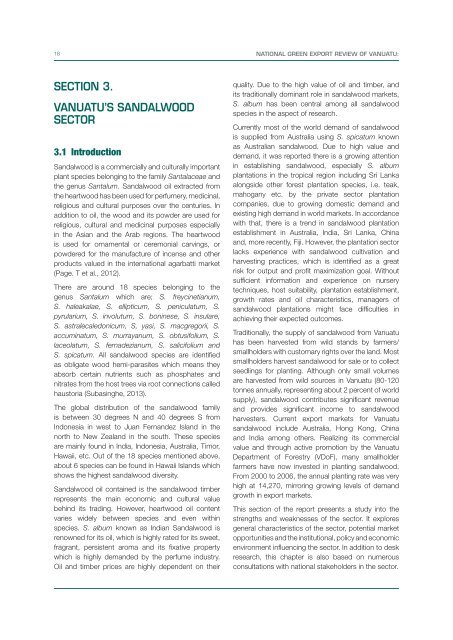VANUATU
Qffx302d60u
Qffx302d60u
You also want an ePaper? Increase the reach of your titles
YUMPU automatically turns print PDFs into web optimized ePapers that Google loves.
18 National Green Export Review of Vanuatu:<br />
Section 3.<br />
Vanuatu’s Sandalwood<br />
Sector<br />
3.1 Introduction<br />
Sandalwood is a commercially and culturally important<br />
plant species belonging to the family Santalaceae and<br />
the genus Santalum. Sandalwood oil extracted from<br />
the heartwood has been used for perfumery, medicinal,<br />
religious and cultural purposes over the centuries. In<br />
addition to oil, the wood and its powder are used for<br />
religious, cultural and medicinal purposes especially<br />
in the Asian and the Arab regions. The heartwood<br />
is used for ornamental or ceremonial carvings, or<br />
powdered for the manufacture of incense and other<br />
products valued in the international agarbatti market<br />
(Page. T et al., 2012).<br />
There are around 18 species belonging to the<br />
genus Santalum which are; S. freycinetianum,<br />
S. haleakalae, S. ellipticum, S. peniculatum, S.<br />
pyrularium, S. involutum, S. boninese, S. insulare,<br />
S. astralecaledonicum, S, yasi, S. macgregorii, S.<br />
accuminatum, S. murrayanum, S. obtusifolium, S.<br />
laceolatum, S. fernadezianum, S. salicifolium and<br />
S. spicatum. All sandalwood species are identified<br />
as obligate wood hemi-parasites which means they<br />
absorb certain nutrients such as phosphates and<br />
nitrates from the host trees via root connections called<br />
haustoria (Subasinghe, 2013).<br />
The global distribution of the sandalwood family<br />
is between 30 degrees N and 40 degrees S from<br />
Indonesia in west to Juan Fernandez Island in the<br />
north to New Zealand in the south. These species<br />
are mainly found in India, Indonesia, Australia, Timor,<br />
Hawaii, etc. Out of the 18 species mentioned above,<br />
about 6 species can be found in Hawaii Islands which<br />
shows the highest sandalwood diversity.<br />
Sandalwood oil contained is the sandalwood timber<br />
represents the main economic and cultural value<br />
behind its trading. However, heartwood oil content<br />
varies widely between species and even within<br />
species. S. album known as Indian Sandalwood is<br />
renowned for its oil, which is highly rated for its sweet,<br />
fragrant, persistent aroma and its fixative property<br />
which is highly demanded by the perfume industry.<br />
Oil and timber prices are highly dependent on their<br />
quality. Due to the high value of oil and timber, and<br />
its traditionally dominant role in sandalwood markets,<br />
S. album has been central among all sandalwood<br />
species in the aspect of research.<br />
Currently most of the world demand of sandalwood<br />
is supplied from Australia using S. spicatum known<br />
as Australian sandalwood. Due to high value and<br />
demand, it was reported there is a growing attention<br />
in establishing sandalwood, especially S. album<br />
plantations in the tropical region including Sri Lanka<br />
alongside other forest plantation species, i.e. teak,<br />
mahogany etc. by the private sector plantation<br />
companies, due to growing domestic demand and<br />
existing high demand in world markets. In accordance<br />
with that, there is a trend in sandalwood plantation<br />
establishment in Australia, India, Sri Lanka, China<br />
and, more recently, Fiji. However, the plantation sector<br />
lacks experience with sandalwood cultivation and<br />
harvesting practices, which is identified as a great<br />
risk for output and profit maximization goal. Without<br />
sufficient information and experience on nursery<br />
techniques, host suitability, plantation establishment,<br />
growth rates and oil characteristics, managers of<br />
sandalwood plantations might face difficulties in<br />
achieving their expected outcomes.<br />
Traditionally, the supply of sandalwood from Vanuatu<br />
has been harvested from wild stands by farmers/<br />
smallholders with customary rights over the land. Most<br />
smallholders harvest sandalwood for sale or to collect<br />
seedlings for planting. Although only small volumes<br />
are harvested from wild sources in Vanuatu (80-120<br />
tonnes annually, representing about 2 percent of world<br />
supply), sandalwood contributes significant revenue<br />
and provides significant income to sandalwood<br />
harvesters. Current export markets for Vanuatu<br />
sandalwood include Australia, Hong Kong, China<br />
and India among others. Realizing its commercial<br />
value and through active promotion by the Vanuatu<br />
Department of Forestry (VDoF), many smallholder<br />
farmers have now invested in planting sandalwood.<br />
From 2000 to 2006, the annual planting rate was very<br />
high at 14,270, mirroring growing levels of demand<br />
growth in export markets.<br />
This section of the report presents a study into the<br />
strengths and weaknesses of the sector. It explores<br />
general characteristics of the sector, potential market<br />
opportunities and the institutional, policy and economic<br />
environment influencing the sector. In addition to desk<br />
research, this chapter is also based on numerous<br />
consultations with national stakeholders in the sector.


